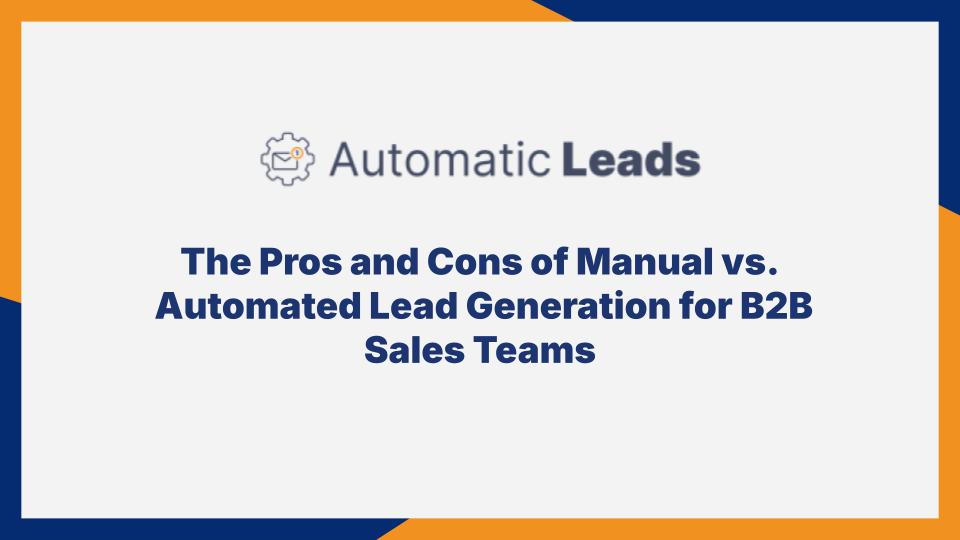Lead generation is the lifeblood of any B2B sales team, but the methods you choose can significantly impact your results.
Traditionally, manual lead generation has been the go-to approach, relying on personalised outreach and human connection.
However, with the rise of automation, many businesses are shifting towards automated lead generation to streamline their efforts and scale their reach.
In this article, we’ll explore the pros and cons of both manual and automated lead generation to help you decide which approach is best for your B2B sales team.
The Pros of Manual Lead Generation
- Personalised Engagement
- Manual lead generation allows for highly personalised interactions with potential customers. Sales reps can tailor their messages to each individual prospect, addressing specific needs and building a genuine rapport. This level of personalisation can foster trust and strengthen relationships, making prospects more likely to convert.
- Human Touch
- Many buyers appreciate the human touch that manual lead generation offers. A personalised email or phone call can make prospects feel valued and understood, which can be especially important in B2B sales, where decisions are often complex and relationship-driven.
- Flexibility and Adaptability
- Sales reps can quickly adjust their approach based on the prospect’s responses and feedback. This flexibility allows for real-time adjustments to messaging, tone, and tactics, making it easier to address objections and tailor the conversation to the prospect’s unique situation.
- Detailed Market Insights
- Through direct conversations, sales reps can gather valuable insights into customer pain points, preferences, and decision-making processes. This information can inform marketing strategies and provide a deeper understanding of the market.
The Cons of Manual Lead Generation
- Time-Consuming
- Manual lead generation requires significant time and effort. Sales reps need to research prospects, craft personalised messages, and follow up consistently. This can limit the number of leads a sales team can reach, especially for smaller teams with limited resources.
- Scalability Challenges
- As businesses grow, it becomes difficult to scale manual lead generation efforts without expanding the sales team. Reaching hundreds of prospects daily is simply not feasible with a manual approach, limiting the potential for rapid growth.
- Inconsistent Follow-Up
- Human error can lead to missed follow-ups and inconsistent communication. Without a system in place to track interactions and schedule follow-ups, valuable leads can fall through the cracks, reducing overall conversion rates.
- Higher Costs
- Manual lead generation can be costly, particularly in terms of labour. The need for additional sales reps or outsourced resources can increase expenses, impacting your bottom line.
The Pros of Automated Lead Generation
- Efficiency and Speed
- Automated lead generation allows you to reach a large number of prospects quickly and efficiently. With the ability to contact hundreds of leads daily, you can scale your outreach efforts without needing to expand your sales team.
- Consistent Follow-Up
- Automation ensures that every lead receives timely follow-ups through pre-set sequences. This consistency helps keep your brand top-of-mind, increasing the likelihood of conversion and reducing the chance of leads slipping through the cracks.
- Data-Driven Insights
- Automated systems track and analyse data from every interaction, providing insights into open rates, click-through rates, and responses. This data helps you refine your approach, identify patterns, and make data-driven decisions that improve your lead generation strategy over time.
- Cost-Effectiveness
- Although there’s an initial investment in setting up an automated system, it can be more cost-effective in the long run. Automation reduces the need for additional labour and enables your sales team to focus on closing deals, which can increase ROI.
The Cons of Automated Lead Generation
- Lack of Personal Touch
- Automated systems can lack the personal touch that manual lead generation offers. Prospects may receive templated messages that feel generic, which can make it harder to build a genuine connection. Personalisation can be added, but it may not match the level of customisation achievable through manual outreach.
- Potential for Spam
- If not carefully managed, automated systems can lead to over-communication or irrelevant messaging, which may be perceived as spam by prospects. This can damage your brand’s reputation and potentially result in unsubscribes or spam complaints.
- Complex Setup and Maintenance
- Implementing an automated lead generation system requires an upfront investment in time and resources. Setting up workflows, creating content, and configuring tracking mechanisms can be complex, particularly for businesses without in-house expertise. Ongoing maintenance and optimisation are also required to ensure the system remains effective.
- Over-Reliance on Technology
- Automated systems can sometimes miss nuances that a human touch would catch. For example, certain prospects may respond better to specific types of messaging, which a one-size-fits-all approach may not accommodate.
Which Approach is Right for Your Business?
Choosing between manual and automated lead generation depends on your business’s specific needs, resources, and goals.
If personal connection and flexibility are top priorities, manual lead generation may be the best choice.
However, if you’re looking to scale your outreach efforts, improve efficiency, and gather data-driven insights, automation could be a game-changer.
For many businesses, a hybrid approach offers the best of both worlds.
Combining the personal touch of manual lead generation with the efficiency and scalability of automation can create a more effective and balanced strategy.
For example, you could use automated systems for initial outreach and lead nurturing, while your sales team focuses on engaging with qualified leads at key points in the sales funnel.
Ultimately, the most effective lead generation strategy is one that aligns with your business objectives, maximises your resources, and delivers measurable results.
By understanding the pros and cons of both manual and automated lead generation, you can make informed decisions that drive growth and improve your sales performance.

